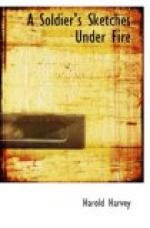[Illustration: The Woodcutter’s hut.]
Our champion at the game was a Private Hyatt—quite a youngster, but of fine physique and fearless daring. His dug-out was called “The Woodcutter’s Hut.” He made a regular hobby of wood-getting. He was an expert, a specialist. On certain occasions he even went out after wood in the daylight, slithering along on all fours towards his objective, and would be fired at until recalled by one of his own officers. On one occasion when he had crawled out and into a building to collect wood, as he crawled back through the doorway we saw little clouds of dust rising from the brick-work surrounding him, which showed that the enemy’s snipers had spotted him, and we shouted to him from the trench to “keep down.” He took refuge behind the wall of the doorway, and lay there three-quarters of an hour, and then returned, bringing with him the much prized plank of which he had gone in search, and which, when chopped up, supplied our section with sufficient firewood for a whole day and night. In the sketch it will be observed he is reading a letter. This he had received just after the above incident, and sat down on his valise quite unaware that I was sketching him. Later on I gave him a copy of the sketch, and he enclosed it in his affectionate reply to his folk at home.
“Stand to.”
The most anxious time a soldier can know is the time, be it long or short, that follows the command to stand to. Many a time we had to stand to the whole night—the entire battalion, from evening twilight till the full dawn of day—as an attack was expected. Everyone was at his firing position, with bayonet fixed and his rifle loaded—and in tip-top working condition, the daily rifle inspection having taken place at dusk. Sometimes our artillery would presently open fire for the enemy’s first line, perhaps for five or six minutes—it might be more, it might be less. Then a wait of six or seven minutes, when the enemy returned the fire, and we all got well down. It was as well to keep as hard up against the parapet as possible, and to keep out of all dug-outs, for into them the forward impetus of bursting shrapnel was likely to throw a lot of splinters. Again silence, comrades and pals passing a few remarks in anticipation of what everybody knew was coming. The officers with us were one with us, and at their words, “Well,




